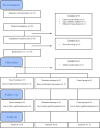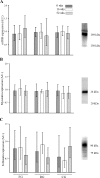The Effects of 52 Weeks of Soccer or Resistance Training on Body Composition and Muscle Function in +65-Year-Old Healthy Males--A Randomized Controlled Trial
- PMID: 26886262
- PMCID: PMC4757560
- DOI: 10.1371/journal.pone.0148236
The Effects of 52 Weeks of Soccer or Resistance Training on Body Composition and Muscle Function in +65-Year-Old Healthy Males--A Randomized Controlled Trial
Abstract
The effects of 52 weeks of soccer or resistance training were investigated in untrained elderly men. The subjects aged 68.1±2.1 yrs were randomised into a soccer (SG; n = 9), a resistance (RG; n = 9) and a control group (CG; n = 8). The subjects in SG and RG, respectively, trained 1.7±0.3 and 1.8±0.3 times weekly on average during the intervention period. Muscle function and body composition were determined before and after 16 and 52 weeks of the intervention period. In SG, BMI was reduced by 1.5% and 3.0% (p<0.05) after 16 and 52 weeks, respectively, unchanged in RG and 2% higher (p<0.05) in CG after 52 weeks of the intervention period. In SG, the response to a glucose tolerance test was 16% lower (p<0.05) after 16 wks, but not after 52 wks, compared to before the intervention period, and unchanged in RG and CG. In SG, superoxide dismutase-2 expression was 59% higher (p<0.05) after 52 wks compared to before the intervention period, and unchanged in RG and CG. In RG, upper body lean mass was 3 and 2% higher (p<0.05) after 16 and 52 wks, respectively, compared to before the intervention period, and unchanged in SG and CG. In RG, Akt-2 expression increased by 28% (p<0.01) and follistatin expression decreased by 38% (p<0.05) during the 52-wk intervention period, and was unchanged in SG and CG. Thus, long-term soccer training reduces BMI and improves anti-oxidative capacity, while long-term resistance training impacts muscle protein enzyme expression and increases lean body mass in elderly men. Trial Registration: ClinicalTrials.gov: NCT01530035.
Conflict of interest statement
Figures




References
-
- Weinert BT, Timiras PS. Invited review: Theories of aging. J Appl Physiol (1985) 2003. October;95(4):1706–16. - PubMed
-
- Blair SN, Kohl HW III, Barlow CE, Paffenbarger RS Jr., Gibbons LW, Macera CA. Changes in physical fitness and all-cause mortality. A prospective study of healthy and unhealthy men. JAMA 1995. April 12;273(14):1093–8. - PubMed
-
- Nelson ME, Rejeski WJ, Blair SN, Duncan PW, Judge JO, King AC, et al. Physical activity and public health in older adults: recommendation from the American College of Sports Medicine and the American Heart Association. Med Sci Sports Exerc 2007. August;39(8):1435–45. - PubMed
Publication types
MeSH terms
Substances
Associated data
LinkOut - more resources
Full Text Sources
Other Literature Sources
Medical
Miscellaneous

